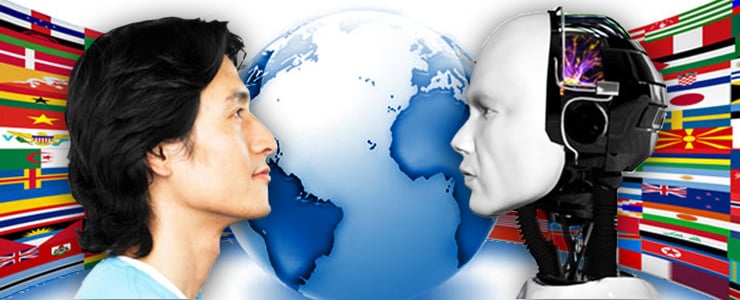
A recent artificial intelligence competition held in Seoul, Korea, allowed human translators to challenge machines in a translation competition. Who got the most accurate translations? From an article written by Kwon O-sung.
Humans faced off against artificial intelligence programs again – this time in the area of translation.
While the battle ended in a resounding win by human beings, the victory may be less important than the questions it raises about future human-machine collaborations.
Organized by the International Interpretation and Translation Association (IITA) and Sejong University, the Human vs. Artificial Intelligence Translation Challenge was held on Feb. 21 at Sejong University in Seoul. For the challenge, four human translators and three AI translation programs tackled the same translation tasks, with scores assigned by a group of three IITA experts, including association chairperson Gwak Jung-cheol, who selected the content. Representing the human side were professional translators of different genders and ages, ranging from a woman of 30 to a man of 55. On the AI side, translations were performed by Google Translate, Naver’s Papago, and a Systran translation program.
Translation competition results showed human translators scoring an average of 24.5 out of 30 points – far ahead of the 10 points averaged by machines. Four categories of assessment were used: literary translation from English to Korean and from Korean to English, and non-literary translation from English to Korean and from Korean to English. The human translators spent 50 minutes to translate the content. For the machine translations, the passages were input into widely available online translation services, after which the translations were checked.
Unlike Go, translation is not a game with clear winners and losers, so the victory itself did not hold great meaning.
“Go is a game where it is obvious who won and lost, but with translation you can’t really say there is any objective standard for victory,” said Shin Seok-hwan, vice president of the artificial neural network technology company Saltlux, while attending a round table on AI translation held at the same venue that day.
“It’s significant as a confirmation of the usefulness of machine translation,” he added.
Google and Naver approved the use of their online services by the organizers, but were not otherwise involved in the event.
Humans still outsmart AI in translation competition
People are still able to translate more accurately than the most advanced machines; next step is human-machine collaboration
Some are saying rapid advancements in artificial neural network machine translation mean it is time to consider ways in which humans and machines can coexist.
“There have long been efforts to generate cooperation between humans and machines in the translation field,” said Kim Yu-seok, director of strategy for the machine translation company Systran.
“What is so significant about the emergence of AI translation last year is that it means machines are at a level where they can collaborate with humans. The task that lies ahead concerns how to efficiently generate a translation work stream divided between humans and machines,” Kim added.
Korea Association of Translation Studies president Hur Myung-soo said education efforts were being launched to “train translators who know how to use machine translations.”
Leave a Reply